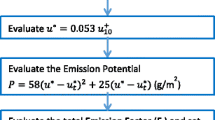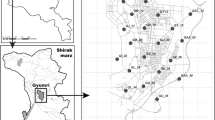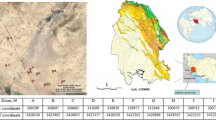Abstract
This work presents a modeling approach to simulate spatial distribution of metal contamination in aerosols with evaluation of health hazard. This approach offers the advantage to be non-intrusive, less expensive than sampling and laboratory analyses. It was applied to assess the impact of metal-bearing dust from mining wastes on air quality for a nearby community and agricultural lands in Jebel Ressas (Tunisia) locality. Dust emission rates were calculated using existing parameterization adapted to the contamination source composed of mining wastes. Metal concentrations were predicted using a Gaussian model (fugitive dust model) with, as input: emission rates, dump physical parameters and meteorological data measured in situ for 30 days in summertime. Metal concentration maps were built from calculated PM10 particle concentrations. They evidence the areas where Pb and Cd concentrations exceeded WHO guidelines (0.5 and 0.005 µg/m3, respectively). Maximum concentrations of Pb and Cd in PM10 are, respectively, of 5.74 and 0.0768 µg/m3 for measured wind speed values up to 22 m/s. Preferential areas of contamination were determined in agricultural lands to the NW from the source dump where Pb and Cd exceeded guidelines up to a distance of 1,200 m. The secondary spreading directions were SW and E, toward the village. Health hazard prospecting shown that a major part of the village was exposed to contaminated dust and that daily hazard quotient (HQ) values reached locally 118 and 158, respectively, for Pb and Cd during the study period. However, HQ variations in the village are high, both temporally and geographically.








Similar content being viewed by others
References
Abdul-Wahab, S. A. (2006). Impact of fugitive dust emissions from cement plants on nearby communities. Ecological Modelling, 195(3), 338–348.
Alfaro, S. C., Gaudichet, A., Gomes, L., & Maillé, M. (1997). Modeling the size distribution of a soil aerosol produced by sandblasting. Journal of Geophysical Research, 102(10), 11239–11249.
Alfaro, S. C., & Gomes, L. (2001). Modeling mineral aerosol production by wind erosion: Emission intensities and aerosol size distributions in source areas. Journal of Geophysical Research, 106(16), 18075–18084.
Armbrust, D. V., Chepil, W. S., & Siddoway, F. H. (1964). Effects of ridges on erosion of soil by wind. Soil Science. Society of America, Proceedings, 28, 557–560.
Baars, A. J., Theelen, R. M. C., Janssen, P. J. C. M., Hesse, J. M., van Apeldoorn, M. E., Meijerink, M. C. M., Verdam, L., & Zeilmaker, M. J. (2001). Re-evaluation of human toxicological maximum permissible risk levels. RIVM report 711701025, Bilthoven, the Netherlands. http://www.rivm.nl/bibliotheek/rapporten/711701025.pdf. Accessed February 1, 2014.
Baize, D. (1997). Teneurs totales en éléments traces métalliques dans les sols (France). INRA Editions, Paris.
Cangialosi, F., Intini, G., Liberti, L., Notarnicola, M., & Stellacci, P. (2008). Health risk assessment of air emissions from a municipal solid waste incineration plant—A case study. Waste Management, 28, 885–895.
Carrizales, L., Raso, I., Tallez-Hernandez, J. I., Torres-Nerio, R., Torres, A., Batres, L. E., et al. (2006). Exposure to arsenic and lead of children living near a copper-smelter in San Luis Potosi, Mexico: Importance of soil contamination for exposure of children. Environmental Research, 101, 1–10.
Chane Kon, L., Durucan, S., & Korre, A. (2007). The development and application of a wind erosion model for the assessment of fugitive dust emissions from mine tailings dumps. International Journal of Mining, Reclamation and Environment, 21(3), 198–218.
Chaulya, S. K., Ahmad, M., Singh, R. S., Bandopadhyay, L. K., Bondyopadhay, C., & Mondal, G. C. (2003). Validation of two air quality models for Indian mining conditions. Environmental Monitoring and Assessment, 82, 23–43.
Cordier, S., Chevrier, C., Robert-Gnansia, E., Lorente, M., Brula, P., & Hours, M. (2004). Risk of congenital anomalies in the vicinity of municipal solid waste incinerators. Journal of Occupational and Environmental Medicine, 61, 8–15.
Fryer, M., Collins, C. D., Ferrier, H., Colvile, R. N., & Nieuwenhuijsen, M. J. (2006). Human exposure modelling for chemical risk assessment: A review of current approaches and research and policy implications. Environmental Science & Policy, 9, 261–274.
Garrat, J. R. (1977). Aerodynamic roughness and mean monthly surface stress over Australia. CSIR, Division of Atmospheric Physics Technical paper, 29, 1–19.
Ghorbel, M. (2012). Contamination métallique issue des déchets de l’ancien site minier de Jebel Ressas: modélisation des mécanismes de transfert et conception de cartes d’aléa post-mine dans un contexte carbonaté et sous un climat semi-aride. Evaluation du risque pour la santé humaine. PhD thesis. Tunis El manar univ and Toulouse univ.
Ghorbel, M., Munoz, M., Courjault-Radé, P., Destrigneville, C., Souissi, R., Souissi, F., et al. (2010). Health risk assessment for human exposure by direct ingestion of Pb, Cd, Zn bearing dust in the former miner’s village of Jebel Ressas (NE Tunisia). European Journal of Mineralogy, 22, 639–649.
Jarvis, P. G., James, G. B., & Landsberg, J. J. (1976). Coniferous forest. In J. L. Monteith (Ed.), Vegetation and the atmosphere (pp. 171–240). London: Academic Press.
Kakosimos, K. E., Assael, M. J., Lioumbas, J. S., & Spiridis, A. S. (2011). Atmospheric dispersion modelling of the fugitive particulate matter from overburden dumps with numerical and integral models. Atmospheric Pollution Research, 2, 24–33.
Lee, J. S., Chon, H. T., & Kim, K. W. (2005). Human risk assessment of As, Cd, Cu and Zn in the abandoned metal mine site. Environmental Geochemistry and Health, 27, 185–191.
Loosmore, G. A., & Hunt, J. R. (2000). Below threshold, non abraded dust resuspension. Journal of Geophysical Research, 105, 20663–20671.
Malcoe, L. H., Lynch, R. A., Crozier Keger, M., & Skaggs, V. J. (2002). Lead sources, behaviors, and socioeconomic factors in relation to blood lead of Native American and white children: A community-based assessment of a former mining area. Environmental Health Perspectives, 110, 221–231.
Marshall, J. K. (1971). Drag measurements in roughness arrays of varying density and distribution. Agricultural Meteorology, 8, 269–292.
Neumann, C. M., Boulton, J. W., & Sanderson, S. (2009). Wind tunnel simulation of enrironmental controls on fugitive dust emission. Atmospheric Environment, 43, 520–529.
NOAA. (2010). Air Resource Laboratory. http://ready.arl.noaa.gov/READYcmet.php.
Raupach, M. R. (1991). Saltation layers, vegetation canopies and roughness lengths. Acta Mechanica, 1, 83–96.
Raupach, M. R., Thom, A. S., & Edwards, I. (1980). A wind-tunnel study of turbulent flow close to regularly arrayed rough surfaces. Boundary Layer Meteorology, 18, 373–397.
Saleh, A., Fryrear, D. W., & Bilbro, J. D. (1997). Aerodynamic roughness prediction from soil surface roughness measurement. Soil Science, 162, 205–210.
Shao, Y. (2008). Physics and modeling of wind erosion. 2nd revised and expanded edition. Berlin: Springer.
Sinha, S. (1995). Quantification of fugitive particle emission from line source in surface coal mine—An approach. Indian Journal of Environmental Protection, 15(5), 339–343.
Sinha, S., & Banerjee, S. P. (1997). Characterisation of haul road in Indian open cast iron ore mine. Atmospheric Environment, 31(17), 2809–2814.
Trindade, H. A., Pfeiffer, W. C., Londres, H., & Costa-Ribeiro, C. L. (1981). Atmospheric concentration of metals and total suspended particulates in Rio de Janeiro. Environmental Science and Technology, 15, 84–88.
USEPA. (2011). Glossary of Key Terms. http://www.epa.gov/ttn/atw/natamain/gloss1.html.
von Braun, M. C., von Lindern, I. H., Khristoforova, N. K., Kachur, A. H., Yelpatyevsky, P. V., Elpatyevskaya, P. V., et al. (2002). Environmental lead contamination in the Rudnaya Pristan-Dalnegorsk Mining and Smelter District, Russian Far East. Environmental Research, Section A, 88, 164–173.
White, B. R. (1979). Soil transport by winds on Mars. Journal of Geophysical Research, 84, 4643–4651.
WHO. (2000). Air quality guidelines for Europe (2nd ed.). WHO Regional Publications, European series, No 91.
Windfinder. (2013). Statistiques du vent et du climat Tunis-Carthage. http://fr.windfinder.com/windstats/windstatistic_tunis-carthage.htm.
Winges, K. D. (1992). User’s guide for the fugitive dust model. Environmental Protection Agency Report: EPA-910/9-88-202R.
Cigagna, M., Dentoni, V., Grosso, B., & Massacci, G. (2014). Emissions of fugitive dust from mine dumps and tailing basins in South-Western Sardinia. In C. Drebenstedt & R. Singhal (Eds.), Mine planning and equipment selection (pp. 739–747). Berlin: Springer.
Marticorena, B., & Bergametti, G. (1995). Modelling the atmospheric dust cycle: 1. Design of a soil-derived dust emission scheme. Journal of Geophysical Research, 100(8), 16415–16430.
Zakey, A. S., Solmon, F., & Giorgi, F. (2006). Implementation and testing of a desert dust module in a regional climate model. Atmospheric Chemistry and Physics, 6, 4687–4704.
Zhuang, P., McBrideb, M. B., Xiaa, H., Li, N., & Li, Z. (2009). Health risk from heavy metals via consumption of food crops in the vicinity of Dabaoshan mine, South China. Science of the Total Environment, 407, 1551–1561.
Zou, B., Wilson, J. G., Zhan, F. B., & Zeng, Y. (2009). Air pollution exposure assessment methods utilized in epidemiological studies. Journal of Environmental Monitoring, 11, 475–490.
Acknowledgments
We are grateful for the support provided by the IRD Ph.D grant and the CMCU program (N09G 1003). We are indebted to Christiane Cavaré for the quality of her graphics.
Author information
Authors and Affiliations
Corresponding author
Supplementary data: methodology of dust emission and aerosol concentration modeling
Supplementary data: methodology of dust emission and aerosol concentration modeling
Dust emission calculation
The dust emission rate is the sum of the direct soil particle aerodynamic entrainment [f (µg/m2/s)] and of the vertical flux [F (µg/m2/s)] resulting from saltation and sand-blasting processes.
The aerodynamic entrainment function (f) gives the emission rate of mobilized particles on the source surface in the absence of saltation at low wind speed (Loosmore and Hunt 2000 in Shao 2008).
where \( U^{*} \) (m/s) is the friction velocity
K: von Karman’s constant, z: height above the surface, m, z 0: roughness height, m, U: wind speed, m/s, F is the emission flux generated by saltation when wind speed is high enough.
The vertical flux F of particles emitted is first based on the calculation of the horizontal flux of soil saltating particles G (g/m2/s) according to Marticorena and Bergametti (1995):
E: ratio of erodible to total surface (taken to 1 here), C: constant of proportionality with a value of 2.61 determined from wind tunnel experiments (White 1979), ρ a: air density, g: gravity acceleration (m/s2), d p: soil particles diameter (µm), S rel: relative surface occupied by a soil aggregate bin of diameter d p (m2), \( U^{*} \): friction velocity of wind (m/s). It depends on wind velocity and on aerodynamic roughness z 0 of the eroded surface. \( U_{t}^{*} \): threshold friction velocity of wind (m/s): minimal wind friction velocity able to mobilize sand particles by saltation (cf Marticorena and Bergametti 1995 for more details).
Initially, this parameterization is designed for desert dust emissions, and the soil aggregate distribution is related to a given textural class using standard distribution (e.g., Zakey et al. 2006). Here, the soil aggregate distribution has been defined directly from in situ measurements according to the following method.
Samples from DIII surface have been taken in 5 different points by scraping off the surface on 1–2 cm over several hundreds of cm2. The samples were homogenized to make one representative sample from which 500 g were quartered, got rid of the fraction more than 2 mm and then analyzed for grain size.
First, dry grain size separation was performed with an AFNOR column: 1,600, 1,250, 630, 400, 355, 250, 200, 150, 125, 80 and 63 µm.
Then, grain size distribution of fraction below 63 µm was determined using a Coulter LS 200 laser granulometer with a small water volume. Measurement range is between 0.393 and 905 µm.
In the G formulation, the roughness length z 0 (µm) is a very sensitive parameter. We have thus determined the roughness from direct measurement of the surface of DIII mining waste dump.
The surface of dump DIII contains erodible and non-erodible or rough elements. There are two types of rough elements:
-
Plants and stones that are consistently exposed to the wind. The roughness caused by these elements is uniform for all wind directions. Then, it is called isotropic roughness.
-
Ripples with curvilinear forms have different fronts of exposure to wind according to their directions (Fig. 9). Thus, the number of fronts (n) in front of the wind as well as their height (h) and their widths (b) are variable depending on the direction of the wind. The effect of such anisotropic roughness varies with the orientation of the ripple with respect to the direction of the wind. Therefore, wind erosion will not be homogeneous and amounts of emitted dust will vary with wind direction. This effect of anisotropic roughness has been studied to assess the consequences of the presence of grooves of labor in the agricultural land on wind erosion (Saleh et al. 1997; Armbrust et al. 1964).
On DIII, surface rough elements are spread in a heterogeneous way. We distinguished between four different parcels in their aspects of surface roughness which was measured for three wind directions:
-
in the N direction which is the dominant wind direction measured in situ during the period between July 13th and August 12th, 2009.
-
in the SE direction which is the second dominant direction and for which strong winds were common during the period between July 13th and August 12th, 2009.
-
in the NW direction which is the annual prevailing direction known for the region.
We performed measurements of roughness on representative surfaces between 0.25 and 4 m2 according to the dimensions of the rough elements.
For each parcel, we proceeded as follows:
-
1.
We determined the number of isotropic elements (plants, rocks), their widths and their heights.
-
2.
For each wind direction, we determined the number of ripple-fronts exposed to the wind, the width (b) and the height (h) of each front. λ represents the totality (n) of fronts (bh) exposed to the wind on a surface (s) with λ = nbh/s.
Pending on the λ value, z 0 can be calculated using one of the following equations (Marshall 1971; Jarvis et al. 1976; Garrat 1977; Raupach et al. 1980; Raupach 1991) where n, b and h are, respectively, the number, width and the height of the rough element and s is the measurement surface. So that, z 0 = 0.005 h, if λ < 0.1 and z 0 = (0.479 λ − 0.001)h, if λ > 0.1.
The aerodynamic roughness was calculated for the other wind directions in the same way.
An overall roughness z 0g which takes into account the different types of surfaces was calculated by summing the different roughness observed on the dump and weighted by the fractions of surface they occupy.
From the saltation flux, the aerosol vertical emission flux is finally calculated according to Alfaro et al. (1997) approach as:
where i represents three modes of a predefined log-normal emission distribution. G: the saltation flux (µg/m2/s), ρ p: density of particles, β: proportionality constant, p idp : fraction of kinetic energy of particles of each diameter class dp able to generate aerosols of mode i, d i : mass of aerosols of mode i (g), e i : kinetic energy of aerosols of mode i (g cm2/s2).
The total vertical flux is obtained by integrating all flux resulting from each diameter class of surface particles and then by summing the quantities of emitted aerosol.
The model we use did not consider the local turbulence related to the topography of the site. We alleviate this point by calculating emission rate with wind gusts measured every minute. Also, the surface moisture was not considered as we worked in summer season.
Calculation of airborne dust concentrations
PM10 concentrations (µg/m3) have been calculated with the fugitive dust model (FDM, Winges 1992). FDM is a Gaussian plume model designed for computing particle concentrations and deposition rates from fugitive dust emissions. The model is well accepted by USEPA for this purpose. It incorporates transport, dispersion and deposition of pollutants in the atmosphere, using input data for particulate matter (particle diameter, density) and air parameters (wind velocity, wind direction, temperature) measured in the site together with flux of emitted PM10 from the emission model. For the 30 days, 720 data for hourly mean emission rate of PM10 were integrated on FDM.
Pb and Cd concentrations in PM10 were calculated using metal content of dump DIII surface.
Source and receptors
The source, DIII waste dump, is assimilated to a rectangle of 235 m × 150 m.
We considered 2,000 receptor points obtained with a 100 × 100 m gridding over a surface of 20 km2. We also added 30 points over the village.
Rights and permissions
About this article
Cite this article
Ghorbel, M., Munoz, M. & Solmon, F. Health hazard prospecting by modeling wind transfer of metal-bearing dust from mining waste dumps: application to Jebel Ressas Pb–Zn–Cd abandoned mining site (Tunisia). Environ Geochem Health 36, 935–951 (2014). https://doi.org/10.1007/s10653-014-9610-y
Received:
Accepted:
Published:
Issue Date:
DOI: https://doi.org/10.1007/s10653-014-9610-y





